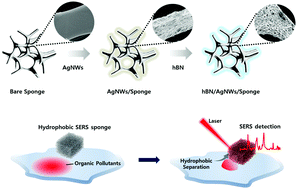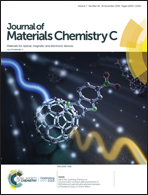Hydrophobic hBN-coated surface-enhanced Raman scattering sponge sensor for simultaneous separation and detection of organic pollutants†
Abstract
A sponge-based surface-enhanced Raman scattering (SERS) sensor composed of silver nanowires (AgNWs) coated with hydrophobic hexagonal boron nitride (hBN) was prepared for the simultaneous separation and detection of organic pollutants. AgNWs adhered on a melamine-sponge surface formed a high density of hotspots for Raman signal enhancement, and hydrophobic hBN coated on AgNWs functioned as an absorbent for the separation of organic pollutants from water via hydrophobic and π–π interactions. Due to the advantages of Raman spectroscopy, which provides an intrinsic molecular Raman signal, typical organic pollutants such as benzene, toluene, ethylbenzene, and xylene (BTEX) were identified by a portable Raman spectrometer with a label-free method after separation through the developed sensor. Further, binary and ternary mixtures of BTEX were also recognized by comparing the Raman spectrum of each component in the mixtures and easily classified by principal component analysis (PCA). Finally, absorbent capacity, reusability tests, and application to environmental water using the developed hBN/AgNWs/sponge samples showed the excellent organic pollutant separation properties as a hydrophobic sponge and the cost effective utilization of the developed sensor for molecular detection. The developed hBN/AgNWs/sponge sensor is expected to be applicable for various on-site and label-free separations and identifications of organic substances, such as environmental and biomedical monitoring.



 Please wait while we load your content...
Please wait while we load your content...